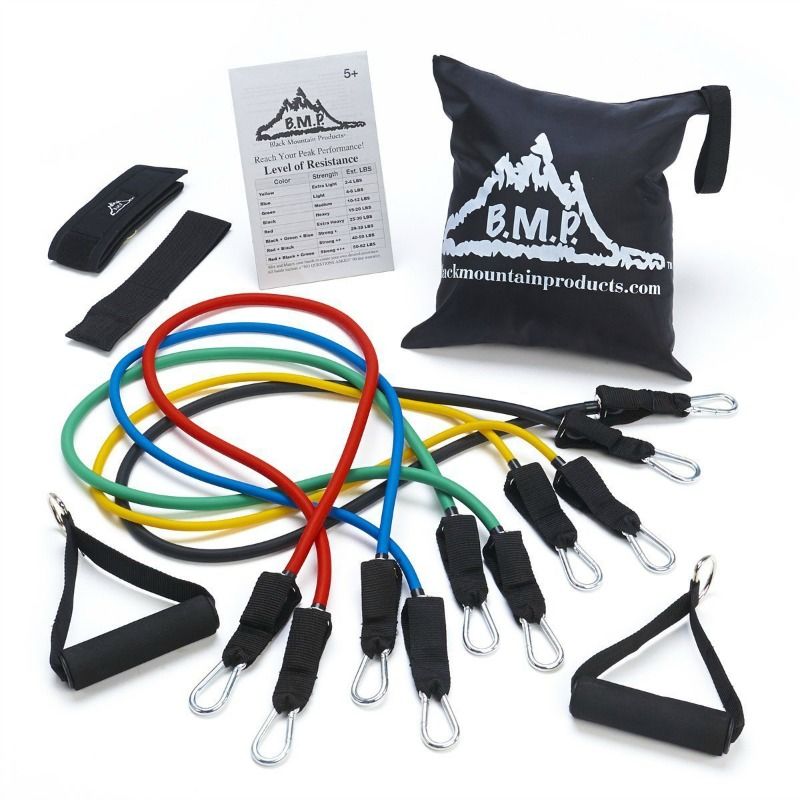In this article
No time? No space for fancy gym equipment?
No worries. You still can get a great workout.
It’s true: You don’t need to invest tons of money in gear or sacrifice hours at the gym to get strong and lean. I’m going to show you how you can get a great fat-burning, muscle-defining workout with minimal equipment in less than 30 minutes.
And when I say “minimal equipment,” I mean just one step up from doing bodyweight exercises. We’re going to use an underappreciated exercise tool that’s inexpensive, lightweight, and adaptable – and it can give you a powerful workout wherever you are.
What, exactly, is this amazing piece of equipment?
The humble resistance band.
Resistance Bands Deserve Some Respect
Traditionally, resistance bands have been used as rehabilitation tools by physical therapists, and as a result they aren’t always recognized for their muscle-building potential.

Looking at those rubbery, multicolored bands, you might find yourself asking,“Can resistance bands really build muscle?”
Yup. Anything that challenges your muscle will cause them to grow.
Your body doesn’t care whether the resistance comes from barbells, machines, bodyweight exercises, resistance bands, or a sack of potatoes.
All your muscles know is that they’re being asked to do something that they find difficult and, as a result, they must grow to keep up.
I would argue, though, that resistance bands are one of the most effective ways to build muscle – even better than some of the more traditional options like dumbbells and barbells.
It all boils down to science.
Resistance Bands vs. Free Weights
Let’s dive into some physics.
First, let’s talk about free weights, which work with gravity to resist your movements.
The amount of resistance that they provide is directly dependent on their relationship with gravity – which pulls things straight down to the ground.
Pretend you’re doing a biceps curl while holding a dumbbell.
When you’re at the bottom of the movement, there’s virtually no resistance. But as you lift it, it gets more challenging, reaching its peak when the dumbbell is parallel to the ground and your elbow is at a 90-degree angle.
And as you continue to lift toward your shoulder, the movement gets easier again.
Resistance bands work differently because they don’t depend on gravity.
The more you stretch them, the more they resist your movement. That means for that same dumbbell biceps curl, you’d have to work harder after your elbow got beyond that 90-degree mark because the band is being forced to stretch even further.
Another thing that I especially love about resistance bands is that they can train your muscles in ways that can be almost impossible with free weights.
For instance, take the standing row – which is a great posture-fixer for those of us who sit a lot.
You can’t even do this exercise, really, with free weights, because it requires you to stand tall while pulling a weight toward the bottom of your rib cage as you squeeze your shoulder blades together. Gravity would make it impossible.
But if you do this same exercise with a resistance band – wrapping it around a sturdy base and then pulling the band along your sides while retracting your shoulder blades – you’ll help strengthen your rhomboids and other posture muscles.
And not only that, resistance bands weigh virtually nothing, are flexible, and can easily go with you wherever you are. If you travel frequently, then, resistance bands are a perfect way to still keep up your workout routine without having to cart around big, bulky weights.
How to Use Resistance Bands
But can you really work most of your major muscles with resistance bands?
Yes, if you set up your program right.
As we’ve seen, resistance bands can be used to work movements that free weights can’t. And because of their adaptability, resistance bands are ideal for adding resistance to large, complex movements that would be extremely difficult – even dangerous – to do with free weights.
I’ve created a simple, quick workout that can be done with a resistance band. You’ll also need a step of some kind and a sturdy post to wrap the band around.
This workout is done circuit-style, meaning that you move quickly from one exercise to the next with no rest between them. For each exercise, do as many reps as you possibly can while maintaining good form in 30 seconds.
Once you’ve completed the circuit, recover for a minute and then repeat. Do the entire circuit a total of 3 or 4 times.
One circuit should take about four and a half minutes to complete, and the entire workout can be completed (depending on many times you do the circuit) in around 20 to 25 minutes.
Since it is a circuit-based routine that focuses on compound movements and large muscle groups, this workout is ideal for burning fat and increasing muscle definition.
As always, be sure to warm up before and cool down after your workout.
Your Resistance Band Workout Routine
Watch the video for the exercise demonstrations (Note: the video is old, but the content is timeless)
Exercise 1: Squat Press
Stand up straight, with your feet about shoulder-width apart and the band firmly under your feet.
Holding one side of the band in each hand, bend your elbows so that your hands are on either side of your face with your palms facing inward and the band on the inside of your wrist.
Keeping your core tight and your back straight throughout the movement, drop into a squat.
As you stand back up, press your hands above your head in a shoulder-press.
Exercise 2: Step ups with Curls
Brace the middle of your resistance band under something heavy on the floor behind you and stand facing a box, chair, or other step with one end of the band in each hand.
Leading with your right leg, step both legs up onto the box. Perform a bicep curl against the band at the top. Slowly step back down and repeat with your left leg.
Exercise 3: Lateral Raises
Stand upright on the band, holding one end in each hand. Keeping your back straight and your core tight, lift arms out to the side until your hands reach shoulder height, keeping elbows soft to protect the joint.
Slowly lower your hands back to the starting position.
Exercise 4: Lateral Lunge with Diagonal Chop
Wrap your band around a strong upright pillar or pole. If your band has handles, use these to create a loop, leaving you with one end of the band to hold on to.
Take a few steps back to place tension in the band and stand with your right side to the pole. Keep your arms straight, your back straight and your core tight during the entire exercise.
With your left leg, lunge out to the side and bring your hands down in a diagonal motion across your body. Return to the starting position. Perform 30 seconds on each side.
Exercise 5: Reverse Lunge with Row
Slide the band higher on the pole, holding a handle in each hand.
Face the pole and take a few steps back to create tension. Take a step backwards with your right leg and drop into the lunge position. When you return to the starting position, pull your shoulder blades back and row against the band.
Perform this exercise for 30 seconds on each leg.
Exercise 6: Alternating Chest Press
Stand with your back to the pole and a handle of the band in each hand. Bring your hands up to chest level. Keeping your core tight and your back straight, push your right arm in front of you. Repeat with your left arm. Alternate arms for 30 seconds.
Exercise 7: Static Squat with One-arm Row
Face the pole and hold one end of the band in each hand. Sink into the squat position, with tension on the bands. Pull your right arm back to perform a row. Repeat on your left arm, alternating sides.
Safe and Effective Workouts
Resistance bands are a great way to work your entire body with a minimum of space, time, and equipment.
And here’s another important tip: Always be sure to inspect your bands for signs of wear before your workouts, so that you stay safe as you get fit.
By incorporating resistance tubing and bodyweight workouts into your routine you can easily get and stay fit no matter where you are.
Looking For More Workout Fun?
Check out this 20-minute bodyweight circuit, which you can alternate with the resistance tube workout. Mixing it up keeps your body guessing and your results coming.
You can download my Bodyweight Circuit Workout, which includes an instructional video, workout tracker, and follow-along audio, right now – for FREE! – by clicking the banner below.


